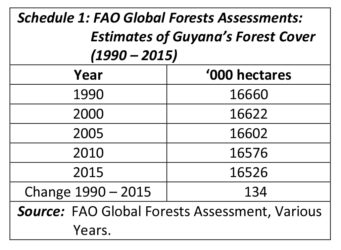The “price of carbon” proxy
Last week’s column introduced estimates of the carbon stock in Guyana’s forests. All estimates of its forest cover, as provided by the FAO’s five Global Forests Assessments held between 1990 and 2015, reveal that, for more than a quarter of a century, Guyana has justified its celebrated status as a “high forest – low deforestation” (HFLD) country. The carbon stock embedded in its forests, contributes Economic Value to the World (EVWc). And,  correspondingly, its forests have an Economic Value to the Nation (EVN), if it should decide to pursue profitable activities (agriculture and mining), which lead to deforestation. “Avoided deforestation” therefore, has a value, for which returns/incentives should justifiably flow to Guyana from the rest of the world.
correspondingly, its forests have an Economic Value to the Nation (EVN), if it should decide to pursue profitable activities (agriculture and mining), which lead to deforestation. “Avoided deforestation” therefore, has a value, for which returns/incentives should justifiably flow to Guyana from the rest of the world.
Schedule 1 displays the estimates of Guyana forest cover provided by the Global Forests Assessments. Based on the work of Denis Alder and Marijke van Kuijk, I had proposed last week, readers’ acceptance of their summary conclusion: “Guyana’s high forest sequester 13 billion tonnes of carbon dioxide in living trees or 16 billion tonnes including deadwood, litter and soils.Across all Guyana, its living ecosystems sequester 18.4 billion tonnes of carbon dioxide”.
Valuing the contribution of forests ecosystems services to the global, or for that matter, any economy is extremely controversial. Nevertheless, there is significant consensus in favour of using the unit price paid for the reduction of a unit of carbon emissions on carbon trading exchanges as a proxy for this valuation. Such exchanges emerged in the mid-2000s, but have yielded considerable variations in the “traded price”; varying between close to zero for their lows and as much as 30 times that for their highs.
In their study Alder and van Kuijk had used a 2008 price of 20 US dollars per tonne carbon dioxide equivalent (tCO2 – e); see Schedule 2. Prices since then have varied well-above and well-below that. Further, the reference price applied in the Low Carbon Development Strategy (LCDS), (written at about the same time, 2008) had employed an “interim carbon price” of US$5 per tonne.
The Paris Agreement
Previously, I offered the observation that, Guyana’s forests policies are heavily driven by the global aspirational agenda for the conservation, sustainable management, and development of these. It was also suggested that, as a small, poor, highly open/dependent, undeveloped and underdeveloped economy, Guyana does not have the institutional, financial, or other resources to forge an independent forest policy path. It therefore needs to work collaboratively with other countries in similar circumstances (CARICOM), SIDS – Small States).
It is imperative however, not to become a slavish follower, but instead use the nation’s enterprise/skills to forge innovative paths. Several global Conventions and Agreements, which Guyana has signed on to in recent decades reveal this. The overarching framework for these is the United Nations Sustainable Development Goals and Targets, 2015-30, agreed to at the Global Summit held in December 2015. The companion agreement to that Summit, is the United Nations Climate Conference, also held in December 2015, in Paris, France.
That Conference produced a global accord: the Paris Agreement. This operates under the broader rubric of the United Nations Framework Convention on Climate Change (UNFCCC). At its core, the Paris Agreement is dedicated towards ending the more than a century— long global dependence on fossil fuels to drive economic growth. On Earth Day (April 22, 2016), nearly 200 countries will have a year (up to April 2017) to sign on to commitments that curb greenhouse gas emissions, in order to prevent global temperatures from rising above 2°C (3.7°F) by 2100; recognizing also the ideal target of 1.5°C (2.7°F).
To achieve this target, countries have pledged emissions curbs. And, to ensure transparency, these pledges will be mandatorily assessed at five-year intervals. Towards this end, the rich countries have also pledged, as a floor, the annual transfer of 100 billion US dollars to the poor ones, starting in 2020. These pledges of emissions cuts are termed Intended Nationally Determined Contributions (INDCs), designed to prevent/contain greenhouse gases resulting from human activity and industrial processes.
Guyana’s INDCs: The irony
Guyana has submitted its revised INDCs to the UNFCCC for the period 2015 to 2025. Its main commitments are in the sectors of forestry and energy. Simply put, it has unconditionally committed “to continue and improve ongoing work to realize sustainable forest management and reliance on renewable energy”. Ironically, these are the very sectors where as Guyana’s INDC submission admits: “the majority of our current and historic emissions are produced.” (Page 5)
Specifically, based on a global carbon emissions loss of 0.44 percent annually and Guyana’s historic annual emissions level of 0.06 percent for the period 2000 to 2009; applying an aboveground and belowground biomass of 19.2 billion tonnes of CO2 e, Guyana will avoid emissions of 48.7 MtCO2 e annually. For the energy sector, Guyana has also committed to the “rapid expansion of a renewable energy supply”; that is, a mix of wind, solar, biomass, and hydropower. Further, its INDCs express the intention that, with “adequate and timely financial support, Guyana can develop a 100 percent renewable power supply by 2025”.







